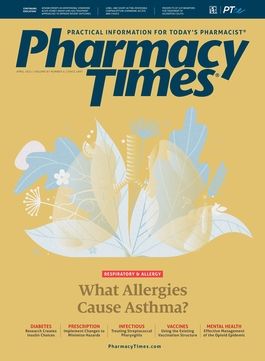Publication
Article
Pharmacy Times
Interactives: Case Studies (April 2021)
Interactive case studies from April 2021.
Case 1
EP is a patient with epilepsy. He has been taking phenytoin at a therapeutic dose for
4 years. EP was recently prescribed valproic acid because he has had breakthrough seizures over the past few months. After taking valproic acid for several days, he calls the pharmacy expressing concern about some new adverse effects. EP describes feeling confused, dizzy, and off balance, and he says he has been slurring his words. He asks whether his new therapy can cause these symptoms.
What should the pharmacist tell him?
Case 2
SA, a 36-year-old man, presents with a 4-month history of heartburn and intermittent difficulty swallowing. The pain is not relieved by eating or by positional changes, and he has tried OTC famotidine and Tums (antacid tablets) with minimal relief. SA takes amlodipine 5 mg orally daily for hypertension and ibuprofen 200 mg as needed for occasional headaches. He has no known drug allergies. He wants to know whether he should try Prilosec (omeprazole) OTC.
How should the pharmacist respond?
Case 1 Answer
Based on EP’s report, his symptoms are consistent with phenytoin toxicity. Both phenytoin and valproic acid are highly bound to plasma proteins. Valproic acid can displace phenytoin from its binding site on protein, leading to higher concentrations of unbound (eg, pharmacologically active) phenytoin. The pharmacist can advise EP to call his prescriber as soon as possible to have a free phenytoin level ordered. A modification to his antiepileptic drug therapy will likely be required.
Case 2 Answer
The pharmacist should advise against further OTC therapies and refer SA to his primary care provider for further evaluation. There are several reasons why SA is not a good candidate for self-treatment. First, his symptoms have persisted for more than 3 months despite treatment with 2 OTC therapies.1 Second, SA has difficulty swallowing (dysphagia), a red flag that may indicate more severe disease, such as cardiac disease.2 The pharmacist can counsel on nonpharmacological interventions, such as avoiding eating close to bedtime and spicy foods, as well as eating smaller meals, but should discourage use of Prilosec OTC.
REFERENCES
Case 1:
- Perucca E, Hebdige S, Frigo GM, Gatti G, Lecchini S, Crema A. Interaction between phenytoin and valproic acid: plasma protein binding and metabolic effects. Clin Pharmacol Ther. 1980;28(6):779-789. doi:10.1038/ clpt.1980.235
Case 2:
- Whetsel T, Garofoli G. Heartburn and Dyspepsia. Handbook of Nonprescription Drugs: An Interactive Approach to Self-Care. Krinsky DL, ed. 20th ed. American Pharmacists Association: 2020.
- Katz PO, Gerson LB, Vela MF. Guidelines for the Diagnosis and Management of Gastroesophageal Reflux Disease. Am J Gastroenterol. 2013;108(3):308-328. doi:10.1038/ajg.2012.444
Author Bios
SINDORELA FRROKU-DIDO is a PharmD candidate at the University of Connecticut School of Pharmacy in Storrs.
STEFANIE C. NIGRO, PHARMD, BCACP, CDE, is an associate clinical professor at the University of Connecticut School of Pharmacy in Storrs.

Newsletter
Stay informed on drug updates, treatment guidelines, and pharmacy practice trends—subscribe to Pharmacy Times for weekly clinical insights.





